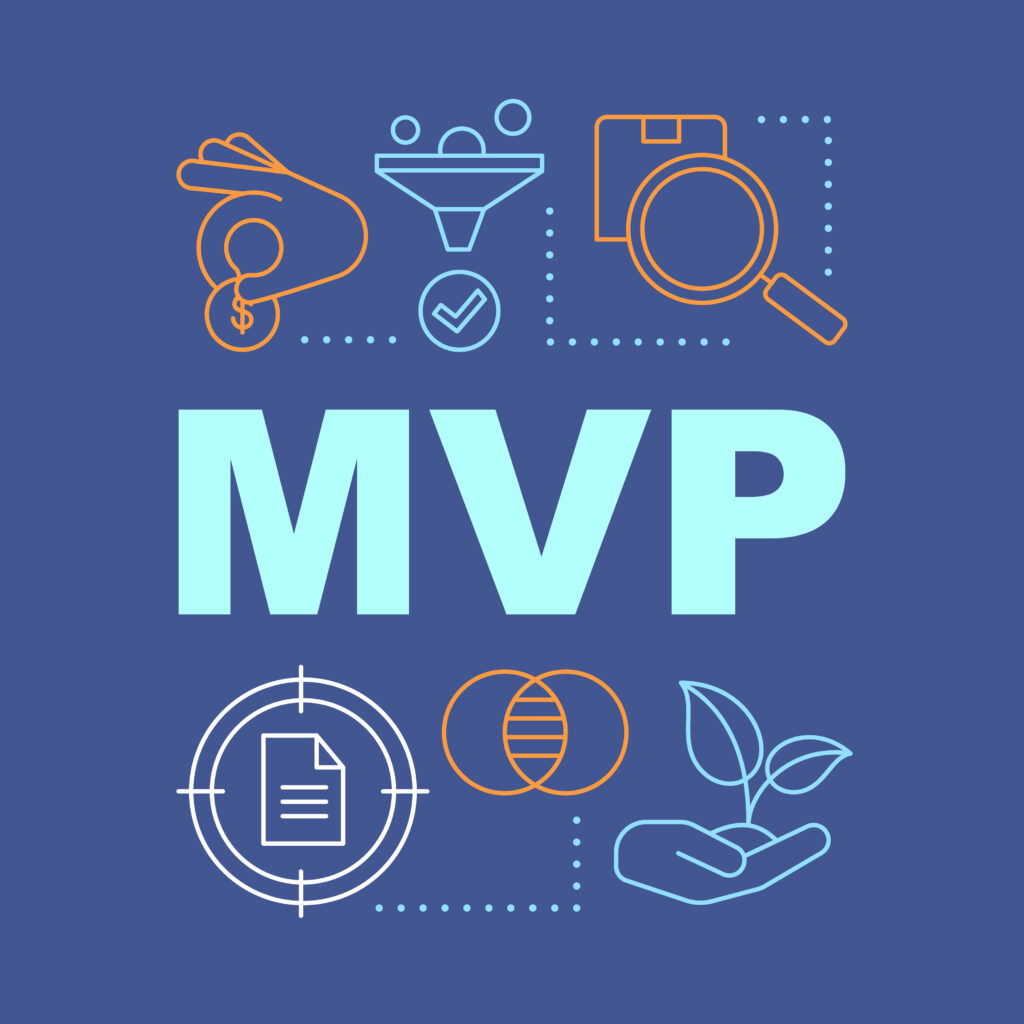Have you ever had a brilliant idea that could save lives? A healthcare software idea- an MVP – that could make doctors’ jobs easier, give patients control of their own healthcare records, or even help perform intricate surgical procedures.
If so, you’re not alone. However, the challenge comes when you’re ready to turn that idea into a reality.
Without a doubt, your next step will determine your success or failure, especially if you have limited software development experience.
Creating a healthcare software product can feel overwhelming, particularly if you have limited experience in the industry. However, with the right approach, your idea can become a reality.
One of the best ways to turn an innovative healthcare software idea into something tangible is to create an MVP (Minimum Viable Product).
For years, software companies have embraced the “minimum viable product” (MVP) approach to efficiently bring their life-improving and compliant healthcare technology to patients and doctors. By leveraging this strategic approach, you can transform your brilliant healthcare software idea into a reality.
Let’s delve deeper and explore the effective MVP strategy that will accelerate your journey toward success.
So What is MVP Software Development, Exactly?

MVP stands for Minimum Viable Product and is a software development method that centers around releasing the product with only its core features intact. With shorter development cycles and fast customer feedback, this approach gets your product to market quickly.
Developers can respond to measured user needs without managing bloat from non-essential features. This lets you iterate and create more robust versions with additional features based on real input.
Eric Ries, an expert in launching successful startups using lean methodology, defined the term MVP as the “version of a new product which allows a team to collect the maximum amount of validated learning about customers with the least effort.”
And MVPs have become an essential part of modern agile software development processes. Many well-known apps started out as MVPs, such as Snapshot, Dropbox, Instagram, Airbnb, and Facebook – making it one of the most successful strategies for launching new products.
Rather than introducing an all-inclusive product, an MVP focuses on the essential features that satisfy the customers’ immediate needs. This expedited strategy facilitates a swift market entry, enabling developers to learn from real customer feedback and adapt quickly.
However, an MVP is not merely a stripped-back version of a product. It must still effectively resolve the customers’ primary concerns, enhancing their user experience while ensuring the product’s stability. Developers should be vigilant about eliminating critical bugs to provide customers with a seamless experience of the product’s core functions.
Keep in mind an MVP isn’t just the starting point for future upgrades. It should be a high-quality, finished product that caters to customers’ immediate requirements.
MVP vs. Prototype vs. PoC: What’s the Difference?

If you’re familiar with early-stage software iterations, you might conclude that MVP is quite similar to the Prototype and Proof of Concept (POC) stages. But in practice, they have different goals, target audiences, and scopes of work.
Proof of Concept (PoC):
- A quick project (like a simple software demo, a piece of complex functionality hard-coded, or even a paper) is designed to demonstrate your concept’s real-world feasibility. The emphasis is not on UX/UI design but on the core tech.
- Target audience: Tech team and project owners.
- Key goal: Examine whether or not a proposed project is technically feasible.
Prototype:
- An interactive model that visually demonstrates the vital user flows and software architecture of a proposed concept.
- Target audience: Project stakeholders
- Key goal: Evaluate the app’s “look and feel” and brush up on the UX/UI before starting with the code.
Minimum Viable Product (MVP):
- A finished, market-ready product with all necessary features for commercial distribution.
- Target audience: End users
- Key goal: Begin early profit-making and user feedback-gathering.
Summarized: An MVP focuses on identifying what users want or need from a minimal version of the product. A prototype focuses on demonstrating whether the design works as envisioned. And a PoC aims to demonstrate overall feasibility by validating the assumptions made during development planning.
Understanding the Benefits of MVP in Healthcare Technology Market Entry

Harvard Business School professor Clayton Christensen, tells us that a staggering 95% of all new products – whether they’re physical or digital – don’t succeed. The reasons for this can vary, but frequently they fall into categories like scaling too quickly, not understanding the target market well enough, failing to meet customer needs, or insufficient product quality. However, these issues can often be side-stepped by initially launching with a Minimal Viable Product (MVP) version of your healthcare product. Here’s what this approach offers:
- It allows you to test your product ideas and concepts with real-world data. This helps you understand what your users need far better.
- The development process is faster, reducing your overall time-to-market.
- MVPs efficiently deliver quick value to your early adopters while gathering crucial information about what they prefer.
- The MVP approach lets you test how well your product fits the market before you invest in full software development.
- It allows you to collect data on how users behave. This can guide your product strategy, inform your decision-making, and help you prioritize.
- You can build a user base even before you’ve fully launched.
- MVPs can streamline your operations and save resources by avoiding investment in unproven ideas.
How Does MVP Development Differ in Healthcare Technology Compare to Other Industries?

To answer this question, you need to understand the main difference between Healthcare IT and other technology industries, two key factors being strict compliance requirements and the level of confidence needed in the outputs to make patient care decisions. So besides common factors, such as user experience and interface, cloud hosting options, performance, and scaling metrics, healthcare software MVP has some special, unique minimum requirements to make it viable before entering the market:
Protect the privacy of any glimpse of patient health information (PHI):
The HIPAA Privacy Rule has long established and refined the requirements for protecting PHI in software. Your MVP plan must identify where your software will potentially store or share PHI (as well as that of your tech partners). Your development requirements must specify what tools will protect PHI (such as encryption and authentication) and show compliance. As a new software venture, you should solicit guidance from a healthcare security compliance expert to establish rock-solid MVP security requirements.
Interoperability — Play well with other healthcare systems:
Healthcare software must work effectively in the flow of many existing IT and data systems. It is crucial to overcome interoperability challenges to create a seamless bridge between different systems for better access to patient records and more efficient care. Additionally, healthcare providers can be assured that all of their information is secure and compliant with industry standards such as HIPAA. The thing to consider here is to use the right technologies to make all systems talk to each other in the ways that best enable faster decision-making, enhance collaboration, reduce confusion, and allow for better overall patient care.
Make your users smile more often:
Vendors developed EHRs with little input from the physicians, which has led to decades of frustration among doctors who feel they spend far more time with computers than patients. Always remember that your technology must make satisfying quality care better and easier for nurses, doctors, and patients who hate redundant effort and data input. Your MVP must aspire to make the healthcare experience better and happier for everyone.
And as you make your way to the healthcare industry with MVP software, you may face countless potential roadblocks.
Look through some of the listed remedies to see if we can help.
What Makes a Successful MVP in the Healthcare Technology Sphere?

The Power of MVPs in Market Learning
MVPs serve as an invaluable tool for understanding the dynamics of the intended market. They allow you to examine the level of market interest in your product before investing heavily in an untested idea. However, poorly executed, minimal viable products may mislead your intended use.
The Risk of Misdirected Focus
A lackluster MVP can lead you to inadvertently target the wrong consumer base, which can result in receiving misleading insights from the market.
The Challenge of Balancing “Minimum” and “Viability”
The distinction between an excellent MVP and an inferior one can be found in how the terms “minimal” and “viable” are interpreted. The word “minimum” in a decent MVP does not suggest “laziness” or “settled for.” It suggests that your product will remain as simple as possible.
However, the challenge arises when a “minimum” product fails to be “viable”. Viability is integral to a successful MVP, ensuring that the product delivers on its promises. A product that fails to meet consumer demand or perform as promised is a surefire recipe for business failure.
The Essential Elements of a Good MVP
While representing only the core of its final form, an MVP that strikes the right balance is ready for use. Avoiding oversimplification, a common cause of MVP failure is crucial. This means refraining from releasing a product with only the bare necessary features or an incomplete version of the product solely for gathering feedback.
Why Should You Start Your Healthcare MVP Development With a Partner?

Just because it’s an MVP, it doesn’t mean it can be developed carelessly or appear in the form of a half-built product. At this stage, consider working with an experienced healthcare technology development partner that can guide you through MVP decision-making and establish a successful long-term product roadmap.
The MVP development process can be especially challenging for new businesses or entrepreneurs entering from different industries since it requires considerable work, knowledge, and many different skill sets, some of which may require niche expertise. Startups often don’t have all the resources available to fill every skill gap, and long hiring processes can slow things down when getting to market quickly is essential.
Considering this, it is vital for companies to develop comprehensive plans, particularly in terms of budgeting, to optimize costs while still ensuring the quality of the MVP for effective experimentation.

Firms can also accelerate the MVP development by collaborating with a trusted partner to enhance the team performance without the costs and challenges of hiring internal resources.
Regarding this, a reliable software development partner, KMS Healthcare, can fill your talent gaps, guide you through common challenges, and help you confidently execute each step. KMS Healthcare can get you started much closer to the finish line with the following:
- A healthcare-experienced development team that can ramp up immediately
- Consulting guidance to ensure a successful delivery
- Skilled data scientists, AI/ML engineers, and leaders in emerging healthcare technologies
- Proven MVP development methodology for startups and enterprises
- Real-world experience from successfully launching our own MVP software
Schedule a free consultation with our experts to bring your healthcare MVP software vision to life.